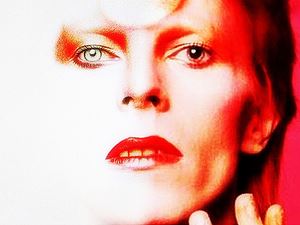
David Robert Jones, better known as David Bowie, was one of the most innovative musicians of our age. He spent a career redefining the art of popular music, using sound and vision to act out his unique, ever-changing aesthetic. It’s precisely that evolution of aesthetic—the different personalities that Bowie wore throughout his life—that make him appeal to so many audiences, that make him appear in so many, often disparate, parts of culture. He, as Rob Sheffield writes in his book, “On Bowie,” “assured his fans we didn’t have to give up on life, didn’t have to play it safe, didn’t have to fall into a rut—and he proved it was possible with his own music.” Bowie used his very life as art, changing the lives of his fans through his morphing aesthetic, answering the question posed in his song, “Young Americans,”—“We’ve lived for just these twenty years—do we have to die for the fifty more?” Bowie’s answer? No. And he proved it by continuing to change and invent and expand right up until his death at age 69.
Many call Bowie a chameleon, but the musician, himself, as Sheffield points out in his book, disagreed with that cliché. Bowie says that “The reinvention thing—I don’t buy into that at all. I think there’s a real continuity with what I do and that’s expressing myself in a contemporaneous fashion. The reinvention thing, it’s an easy description, isn’t it?”
Bowie has ever defied easy description. Sheffield comes close when he writes that Bowie was “a human mix tape listening to the world and echoing back his favorite bits, combining them into something new." His phases weren’t simply reinventions—they were reflections of culture, of what he saw around them, all connected by the nexus of the essential David Bowie.
The many subtle permutations of Bowie were nearly innumerable, but a few stand out, above all others. Ziggy Stardust was, perhaps, Bowie’s most famous persona. The red-haired, androgynous, alien rock-star grew out of Bowie’s observation of American proto-punk artists. Bowie intended to create a character “who looks like he’s landed from Mars.” He succeeded, and created one of the most iconic musical characters of all time.
Aladdin Sane, marked by a red and blue bolt of lightning painted across his face, ushered in Bowie’s celebrity status in America. In this phase, Bowie’s album contained songs he wrote while travelling across the US. From there, he entered the persona of the Thin White Duke, exchanging his extravagant costumes for a more reserved white shirt, black vest, and blond, slicked-back hair. This stage of Bowie’s life was marked by drug abuse and bizarre behavior, and the image of the duke seemed a reflection of his soul, at the time.
Each of these personas was a mixture of himself, his circumstances, and the world around him, expertly remixed into art. Even in the eighteen months preceding his death, Bowie continued to reflect his world—except that this time, with a terminal cancer diagnosis, his world was death. His final album, Blackstar, was released only days before his death, filled with lyrics hinting at his impending passing. Bowie never stopped making the world around him into art. That is an inspiration, and the definitive answer to the question Bowie posed in “Young Americans”.
The purpose of art is, as Pablo Picasso put it, “to wash the daily life off our souls”. It pulls us out of the ordinary, and places us into something magnified, something that is like life, yet utterly transcends it. It washes off the sameness that seeps into our souls each day, helping us to see from new perspectives, to feel and think new things.
This is what looking at Bowie’s life does for us. We grow up thinking that we’re going to own the world—we have a plan, and we’re going to stick to it and find success, whatever that means to us as individuals. But then we start to hit obstacles. We drop out of college, or we divorce. We lose money. We lose a job. We feel we’ve gotten off track, and fall into a rut, the sameness of our day-to-day activities coating our souls in a thick layer of dusty life. We see the same happening to the people around us, too, and we begin to accept it as inevitable, consigning ourselves to our “fate”.
But that’s not what Bowie did. He had his perceived failures—things like his song, “The Laughing Gnome,” that he was not particularly proud of. But he kept changing, kept refreshing his life over and over. Bowie never stood still for a second, even up to the last few months of his life. He, as Sheffield puts it, “kept inventing new worlds just for the pleasure of changing them. And in doing so, he changed our world as well.” Although this is just one single interpretation—one of many, as it is with all great art—of the performance that was Bowie’s life, it is an important one—one that Bowie would likely want his fans to take hold of and live out.
Bowie pushed boundaries wherever he found them, and so can we. We are not static. We are ever-changing, morphing, moving beings who respond to our world in a dynamic way. To deny this is to embrace a false stagnation that can only lead to unhappiness. Sometimes change is necessary, especially so when we fall into the aforementioned ruts, the holes we dig through repeated actions that don’t really lead us anywhere. Just as you might look read a great piece of literature and learn what it means to be a friend or a father or a human being, look on Bowie’s life and learn from it—take from it a bit of what he put into it. Don’t be afraid of entering new phases of your life, no matter how radical or strange or different. It’s the only way to truly stay alive.

